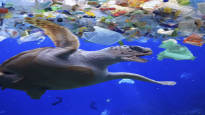Microplastic ends up in animals, and thus also in food. According to the EU, the new plans should prevent the release of around half a million tons of microplastics into the environment.
The European Union has decided to gradually ban the sale of microplastics. The EU also prohibits the sale of products to which microplastics have been added and from which plastic is released during use.
The ban will take effect gradually. The first restrictions will come into effect in a few weeks, on October 15. That’s when the ban on the sale of microbeads and loose glitter comes into effect.
In other cases, the bans will come into effect in the coming years. The purpose of the transition period is to make it easier for the industry to switch to replacement alternatives.
The ban will apply, for example, to rubber crumb on the surface of sports fields. It must be abandoned in the next eight years.
The ban will also apply to cosmetics, such as exfoliating agents.
Microplastic refers to particles of plastic waste less than five millimeters in size. Microplastic particles accumulate in animals, such as fish and crustaceans, and can thus also end up as human food.
The new rules do not apply to products used in industrial plants.
However, their manufacturers must provide instructions on the use and disposal of the product in order to avoid microplastic emissions. Certain exceptions also apply to medicines and food and feed.
